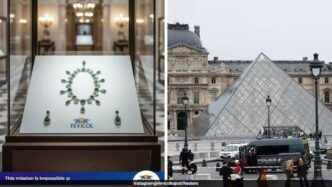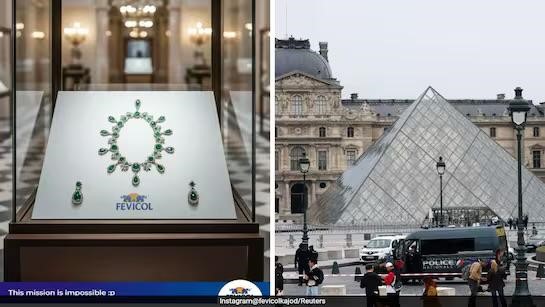On 19 October 2025, one of the most audacious museum thefts in recent memory took place at the Louvre Museum in Paris. Below is a detailed breakdown of what happened, what was stolen, what’s at stake—and what this means for cultural heritage and museum security worldwide.
What happened
- In the morning around 9:30 am local time, shortly after the museum opened, a small group of thieves made their move at the Louvre’s grand galleries.
- The scene: the thieves used a truck-mounted lift (basket lift) to reach a window on the façade of the Louvre, facing the Seine, at the level of the second floor / first floor (depending on floor-naming) near the gallery known as the Galerie d’Apollon.
- Inside: They cut through window panes or glazing, entered the gallery, and smashed two display cases containing royal jewellery.
- Escape: The thieves fled on motorbikes (scooters) with their haul. One of the major items—a crown belonging to Empress Eugénie—was dropped outside the museum during the escape.
- Duration: Authorities estimate the whole operation—from entry to exit—took 4 to 7 minutes.
- Investigation: French prosecutors quickly opened an inquiry, with the specialised unit Brigade de Répression du Banditisme (BRB) tasked with the investigation.
What was stolen
- Authorities confirm that eight pieces of jewellery were stolen from two display cases in the Galerie d’Apollon.
- The items include:
- A tiara, necklace and single earring from a sapphire set once owned by Queen Marie‑Amélie and Queen Hortense.
- An emerald necklace and matching earrings from Empress Marie‑Louise (wife of Napoleon I) from 1810.
- A tiara and large brooch belonging to Empress Eugénie (wife of Napoleon III).
- A tiara, necklace and single earring from a sapphire set once owned by Queen Marie‑Amélie and Queen Hortense.
- One crown (of Empress Eugenie) was recovered, albeit damaged, outside the museum after being dropped during the escape.
- Estimated value: The haul is valued at €88 million (approx. US $102 million) according to Paris prosecutors.
- The significance is far beyond monetary value. Authorities describe the loss as damage to French heritage, far more than just an economic loss.
How they did it & what security failures emerged
- The choice of entry point: the Seine-facing façade underwent construction/works (scaffolding, elevated lift), which appears to have been exploited.
- The thieves used power tools (angle grinders, disc cutters) to cut through window panes and display cases.
- Security gaps:
- The museum’s director admitted that CCTV coverage was inadequate around the relevant façade and gallery.
- The localized alarm in the gallery had reportedly been broken prior to the heist.
- The theft occurred in daylight, in one of the world’s most-visited museums (over 8-9 million visitors annually), raising concerns about staffing, crowd control and vigilance.
- The museum’s director admitted that CCTV coverage was inadequate around the relevant façade and gallery.
- The director of the Louvre, Laurence des Cars, told the Senate that the heist “was not inevitable”, acknowledging vulnerabilities.
Recovery prospects and the clock ticking
- Experts warn that the criminals have a narrow window of 24 – 48 hours to be caught and recover the jewels before they are dismantled, melted down, cut into smaller gems, or sold off in untraceable pieces.
- If the stones are recut or melted, their provenance is lost and chances of recovery drop dramatically.
- Investigators: More than 100 investigators have reportedly been deployed to sift through CCTV, trace motorbike routes, interview staff and review footage of surrounding roads and exit arteries of Paris.
Significance & wider implications
- This case is a potent reminder of the vulnerability of cultural treasures even in highly-public and heavily-visited institutions.
- The loss: It’s not just about monetary value — the stolen items embodied historical and national heritage, linked to France’s imperial and royal past.
- Museum security: The heist spotlights that restoration, renovation and upgrading security for heritage sites is urgent and cannot lag behind. The Louvre’s own “New Renaissance” security and renovation plan (costing hundreds of millions) is under scrutiny.
- On the art crime front: The event could encourage other high-value thefts, which means both public institutions and private collections may face heightened risk.
- For French authorities: This is a reputational blow. The event has already been called a “national humiliation” by some commentators.
What now? What to watch
- Will the thieves be caught, and will the jewels be recovered intact? The next few days are critical.
- How France (and other nations) respond in terms of security reforms for museums and cultural sites.
- The fate of the stolen pieces: Whether they are still intact, or already broken apart and dispersed.
- The legal and criminal investigation: arrests, tracking of escape routes, analysis of tools left behind (one crown was dropped), DNA, CCTV.
- The public and diplomatic fallout: What new measures will be publicly announced, and how the Louvre and France will repair the breach of trust.
In summary
What seemed like a scene out of a heist movie played out in real life inside one of the world’s most famous museums. The robbers acted swiftly, professionally and with surprising ease, striking at a national treasure of France. Whether the stolen jewels will ever be recovered remains uncertain. But one thing is clear: the incident has shaken the heritage world and should serve as a wake-up call for guardians of culture everywhere.
Originally written by:Ian Aikman
- Rachel Hagan
Link:https://www.bbc.com/news/articles/cg7nrlkg0zxo
















